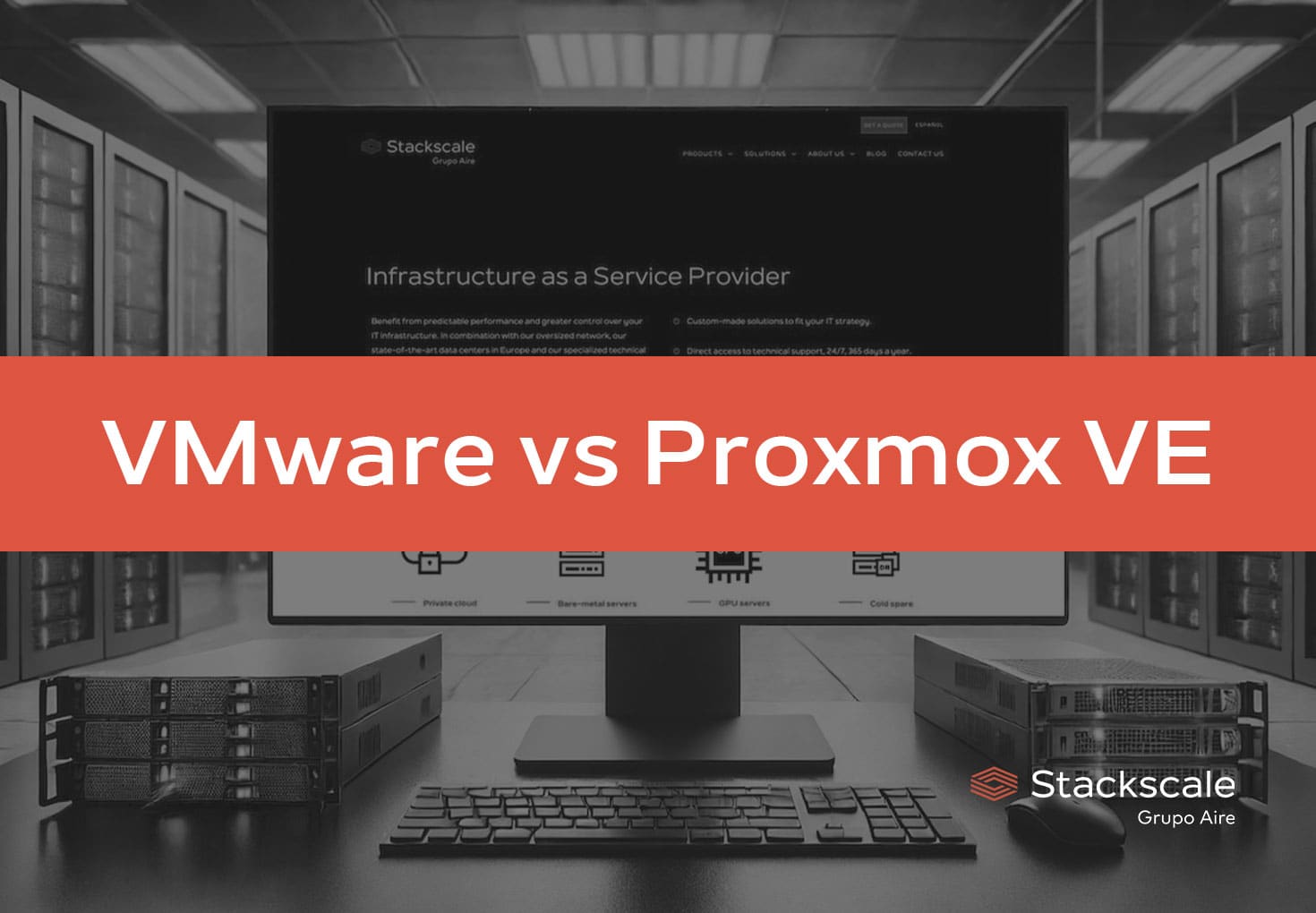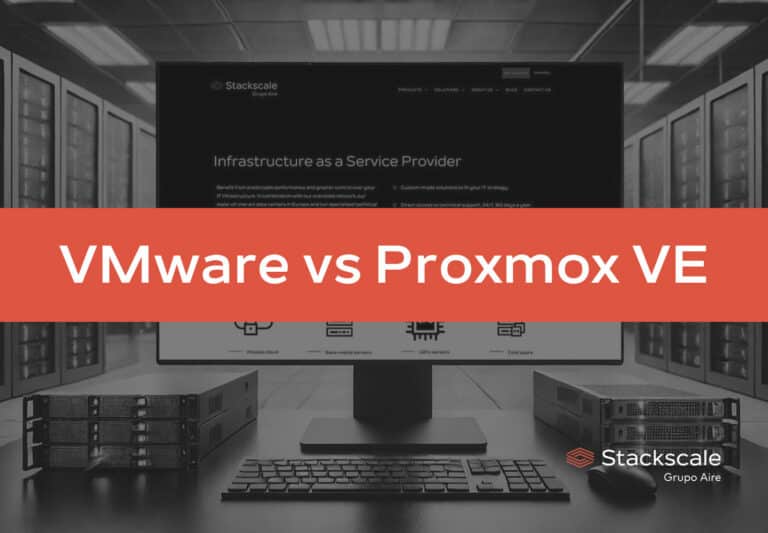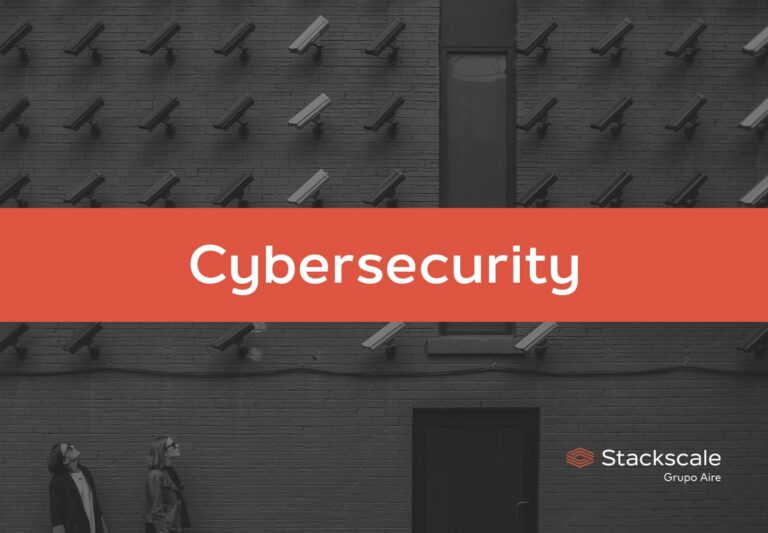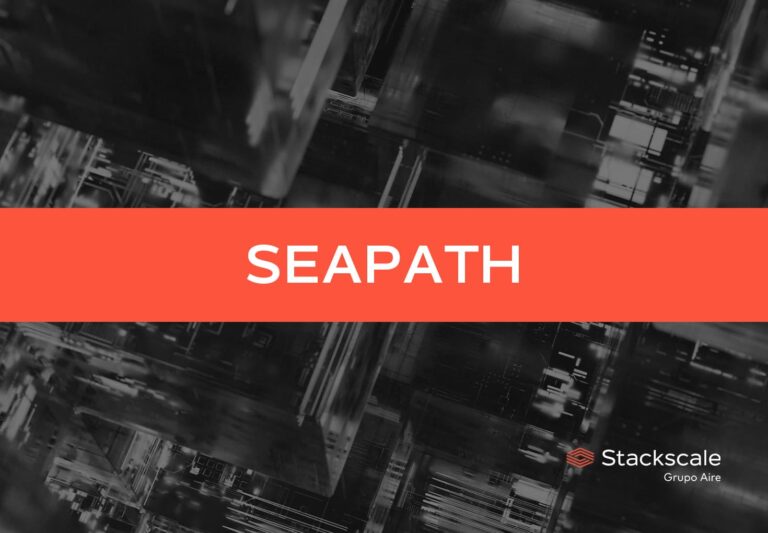At Stackscale we work with VMware vSphere and Proxmox VE every day. Our approach isn’t to “force” a tool, but to fit the platform to the project’s requirements (technical, operational, and business). Below is a practical analysis—aligned with Stackscale’s editorial style—of when each technology makes sense and how that translates into operations, cost, and risk.
Why one-to-one comparisons are often unfair
- VMware vSphere is an end-to-end product with decades of evolution and a broad ecosystem (vCenter, vSAN, etc.), aimed at enterprise environments that require certifications, compatibility matrices, and formal support.
- Proxmox VE is an open distribution that integrates very mature technologies—KVM/QEMU (hypervisor), LXC (containers), ZFS and Ceph (storage)—behind a solid web console and API/CLI (Application Programming Interface / Command-Line Interface).
The value isn’t about “who checks more boxes,” but what you actually use today and across the project’s lifecycle (3–5 years).
Where VMware fits… and where Proxmox shines
When VMware makes sense (and brings everything you need)
- Certifications and compliance: regulated sectors and demanding audits.
- VDI (Virtual Desktop Infrastructure) and graphics workloads: wide vGPU and MIG (Multi-Instance GPU) support with ISV certifications.
- Continuous availability: FT (Fault Tolerance, host-level Tolerance to Failures) with zero downtime and zero loss of in-memory data if a host fails.
- Large-scale operations: DRS (Distributed Resource Scheduler) for resource balancing and vDS (vSphere Distributed Switch) when you want the hypervisor’s own distributed switching (although Stackscale does not depend on it; see the network section).
When Proxmox VE shines (and optimizes TCO)
- Large-scale Linux workloads: hundreds or thousands of VMs with HA (High Availability) and live migration, automation (Ansible/Terraform), and accessible API/CLI.
- SDS (Software-Defined Storage) without vendor lock-in: Ceph integrated or NFS/iSCSI/ZFS depending on the case.
- Native backups: Proxmox Backup Server with scheduling, retention, verification, and immutability.
- Clear failure domains: sensible, segmented clusters (not mega-clusters).
- Cost efficiency (TCO, Total Cost of Ownership): open model with optional support subscription.
Operational comparison (what matters on Monday morning)
| Area | VMware vSphere | Proxmox VE |
|---|---|---|
| Hypervisor | ESXi | KVM/QEMU + LXC |
| Management | vCenter (GUI + API), Aria | Web console + API/CLI |
| Network | vDS (if used); Stackscale network with real VLANs, hypervisor-agnostic | Linux bridge/OVS; Stackscale network with real VLANs, hypervisor-agnostic |
| Local / software-defined storage | vSAN + ecosystem | Ceph integrated; ZFS/NFS/iSCSI |
| Network / synchronous storage (Stackscale) | Available to both: NetApp arrays with synchrony and performance tiers | Available to both: NetApp arrays with synchrony and performance tiers |
| HA / Balancing | Mature HA/DRS | HA + live migration |
| FT (Fault Tolerance) | Yes (zero downtime / zero in-RAM data loss) | No direct equivalent |
| vGPU / MIG | Broad support and certifications | Possible, less standardized |
| Backups | Very large third-party ecosystem | Native backup (PBS) + third parties |
| Support | Global enterprise (SLA) | Optional enterprise subscription |
| Cost / TCO | Higher | Very competitive |
FT (Fault Tolerance): keeps two synchronized instances of the VM on different hosts; if one fails, the secondary takes over instantly with no memory loss. It’s one of vSphere’s enterprise differentiators.
Stackscale networking: real VLANs and a hypervisor-agnostic architecture
At Stackscale we don’t depend on the hypervisor’s software-defined networking. Our network is independent of VMware or Proxmox and delivers real VLANs directly over our private and bare-metal infrastructure.
This enables:
- Extending the same VLAN across VMware clusters, Proxmox clusters, bare-metal servers, and even housing connected to Stackscale.
- Simplifying design, avoiding SDN lock-in at the hypervisor layer, and enabling hybrid VMware ↔ Proxmox ↔ bare-metal scenarios with low latency and high performance.
- Keeping segmentation and control in the Stackscale network itself, instead of tying the topology to hypervisor-specific networking features.
When a project requires especially fine-grained policies or specific security use cases, we implement them on the Stackscale network, keeping the data plane hypervisor-agnostic.
Storage at Stackscale: compute–storage separation, synchronous RTO=0 & RPO=0, and performance tiers
Beyond each stack’s local or SDS options (vSAN/Ceph), Stackscale offers network storage and synchronous storage based on NetApp arrays, designed to decouple compute from storage. This boosts resilience, enables independent scaling, and minimizes recovery times.
Continuity objectives
- RTO=0 (Recovery Time Objective): service continuity with no noticeable downtime in the event of an incident.
- RPO=0 (Recovery Point Objective): zero data loss thanks to synchronous replication.
All-flash performance tiers
- Flash Premium: ultra-low latency and very high IOPS for critical databases, real-time analytics, or high-throughput queues.
- Flash Plus: balance between latency and throughput for app servers, middleware, and mixed workloads.
- Flash Standard: consistent performance and optimized cost for general VMs and steady workloads.
- Archive (backup & retention): capacity-optimized for copies, replicas, and long-term retention.
Protection & continuity
- Frequent, block-efficient snapshot policies.
- Cross-datacenter replication included, providing consistent copies ready for failover/failback.
- Integration with native or third-party backup tools and granular recovery (file/VM).
Combinations
- You can combine Stackscale network storage with vSAN (VMware) or Ceph (Proxmox) depending on design: e.g., SDS for scratch/hot data and NetApp for persistent data with multi-DC replication.
- The outcome: resilience by design, with decoupled planes (compute ↔ network ↔ storage) and RPO/RTO aligned with the service’s criticality.
Total cost and operational risk
- VMware: higher TCO, low operational risk when its catalog and certifications are explicit project requirements.
- Proxmox VE: very competitive TCO, controlled risk when you define failure domains, runbooks, and observability from day one (and work with an experienced partner).
The right decision shows up as stability, predictable costs, and operator velocity.
Design patterns by use case
1) Linux/DevOps workloads (microservices, middleware, queues, non-relational DBs)
- Proxmox VE + Ceph for compute, plus Stackscale network storage (Flash Plus/Standard) for persistent data and replicas.
- Recommendation: many small/medium clusters vs. a mega-cluster; well-defined failure domains.
2) Datacenters with segmentation and complex topologies
- Stackscale network with real VLANs and centralized control, regardless of hypervisor.
- Recommendation: leverage agnostic networking to move or coexist workloads across VMware and Proxmox without redesigning the network plane.
3) VDI and graphics profiles
- VMware + vGPU/MIG and Flash Premium when storage latency affects UX.
- Recommendation: validate profiles and seasonal peaks.
4) Modernization with SDS
- Proxmox VE + Ceph for scratch/hot data, NetApp (Flash Plus/Standard) for persistent data + multi-DC replication.
- Recommendation: separate networks (front/back), NVMe/SSD for journals, monitor placement groups.
Implementation best practices
With Proxmox VE
- Ceph: dedicated networks, CRUSH rules, health alerts.
- Backup: dedicated PBS repositories, restore tests, immutable retention.
- Automation: templates, cloud-init, tagging, quotas, hooks, API/CLI.
- Security: VLAN isolation, cluster firewall, users/roles, host hardening.
With VMware
- Licensing fit: align to actual feature usage.
- Disaster recovery (DR): runbooks, replicas, and periodic drills.
- Capacity: plan DRS and CPU/RAM/IO headroom; enable FT where it adds real value.
Migration with rollback (both directions)
- VMware → Proxmox: inventory and criticality (RPO/RTO), compatibility (virtio, guest tools, cloud-init), storage design (Ceph / NFS / iSCSI or NetApp), controlled pilot, and cutover automation (API/scripts, re-IP if needed).
- Proxmox → VMware: classify by dependency on FT, vGPU, or ISV certs; network mapping (VLANs/segments, port groups); IOPS/latency validation; HA/live migration tests.
How we approach it at Stackscale
- We start from the use case, not the tool.
- We design clusters with clear failure domains, observability, and runbooks from day one.
- We operate and support environments on VMware vSphere and Proxmox VE across private and bare-metal infrastructure.
- Hypervisor-independent networking: we deliver real VLANs and can extend segments across VMware, Proxmox, and bare-metal/housing connected to Stackscale.
- Stackscale storage: NetApp arrays with Flash Premium/Plus/Standard and Archive, snapshots and multi-DC replication included; and a synchronous option with RTO=0 and RPO=0 for workloads that cannot tolerate downtime or data loss.
- We guide migrations: to VMware or Proxmox, and also VMware → Proxmox and Proxmox → VMware, with pilots, defined rollback, and planned maintenance windows. Ask us!
- We iterate: recurring measurements, recovery tests, and adjustments as the project evolves.
Conclusions
- Choose VMware vSphere when advanced features (FT, vGPU), certifications, and enterprise support are explicit requirements.
- Choose Proxmox VE when you prioritize control, cost efficiency, and flexibility, especially for large Linux estates (and SDS with Ceph).
- At Stackscale, both technologies coexist and integrate on a hypervisor-agnostic network and storage, so the architecture serves the project—not the other way around.
FAQ
Does Proxmox VE support Windows?
Yes. Proxmox runs Windows and Linux; its sweet spot is Linux efficiency and the fit with Ceph/ZFS and automation.
Is VMware always more expensive?
It depends on the license profile and actual use of features like FT (Fault Tolerance), vGPU/MIG, or ISV certifications. When these are requirements, their value justifies the cost.
Can I run both?
Yes. It’s common to segment by criticality or workload type: e.g., VDI and certified workloads on VMware, and microservices/DevOps on Proxmox VE with Ceph. Our real-VLAN network and network/synchronous storage make that coexistence straightforward.
What does Stackscale provide in each case?
We design and operate VMware vSphere and Proxmox VE platforms on private and bare-metal infrastructure, with SDS (Ceph), a hypervisor-independent network, and NetApp arrays (Flash Premium/Plus/Standard, Archive) with snapshots and multi-DC replication included—and synchronous options (RTO=0, RPO=0) for critical workloads. We tailor the platform to each project’s needs.




